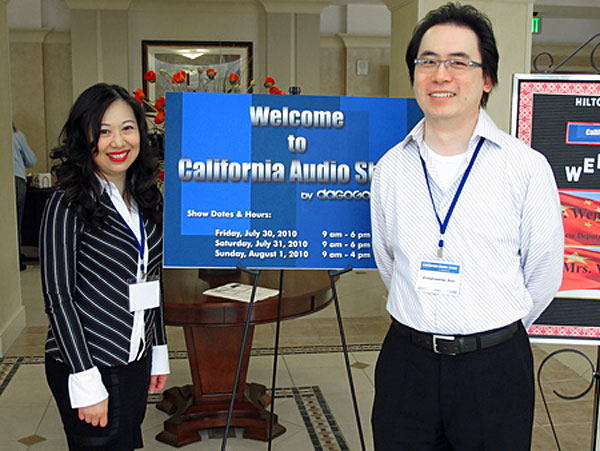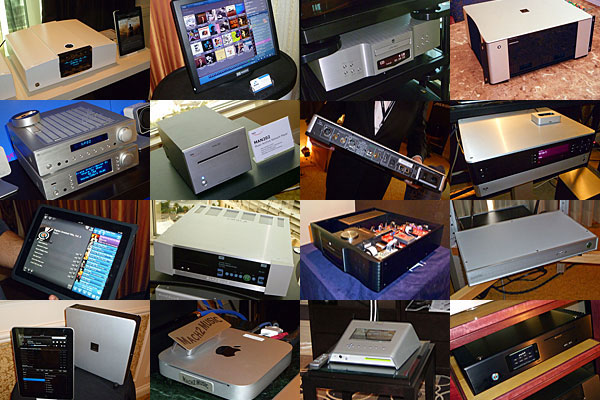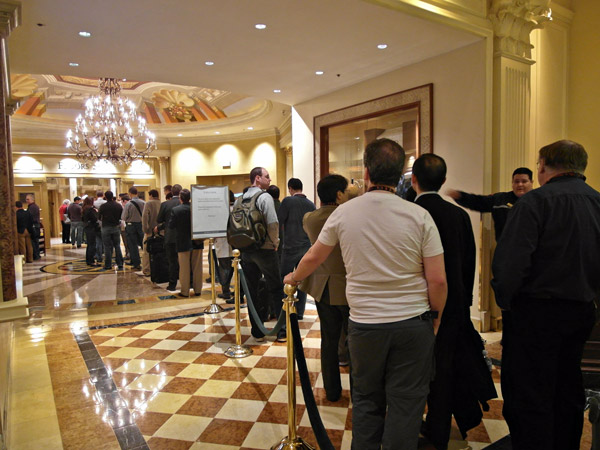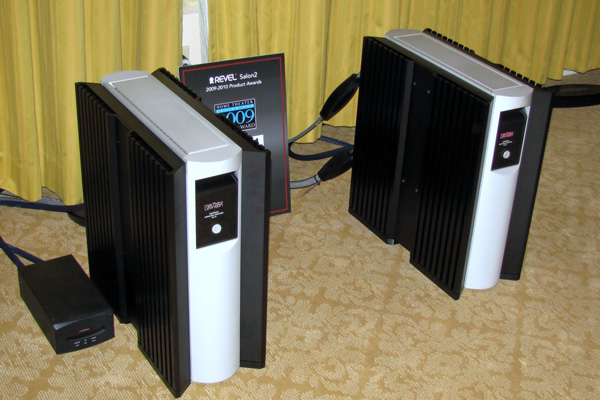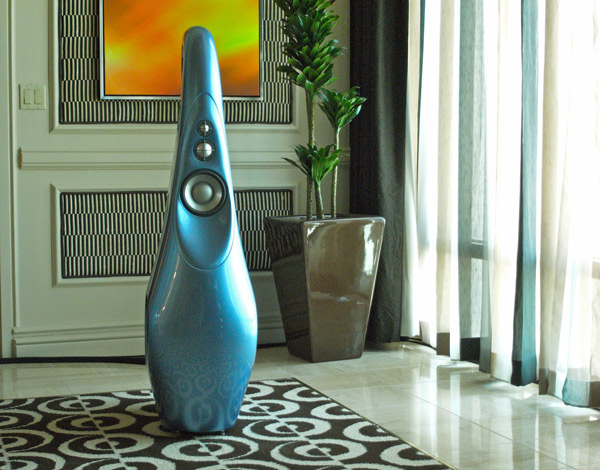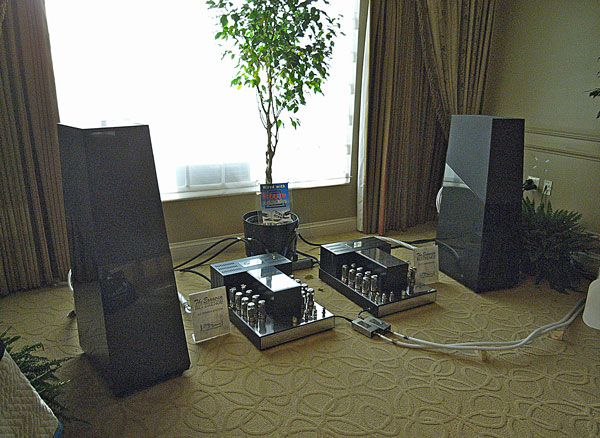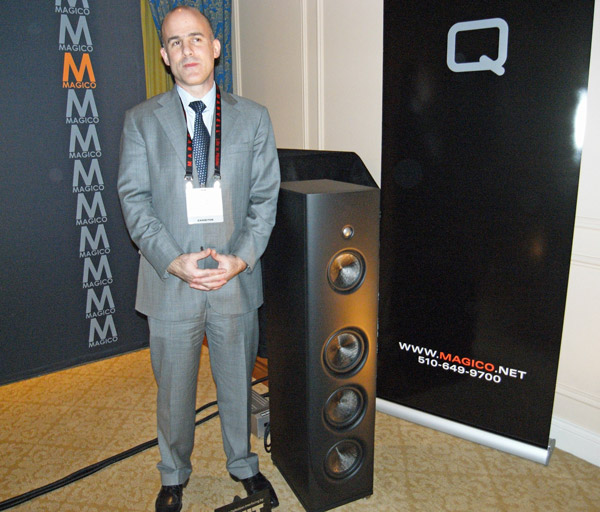LATEST ADDITIONS
Digital Wrap-Up
Click through to see the complete list of what I found with links and an informal taxonomy.
Long Lines at the Venetian
The last time I attended CES was three years ago. Although many things have stayed the same, there were also interesting changessome of them profound. At the Las Vegas Convention Center, it seemed that almost every exhibit had to do with 3D, iPods, or tablet computers. At the Venetian, in addition to the traditional areas of speakers and amplification, it was music servers and related productsably summarized by Jon Iverson in his wrap-up. Cables were big. (More on this anon.)
It was a very crowded show. At the convention center, the scene was at times like being on a subway platform during rush hour. At the Venetian, home of high performance audio, there were long lineups for the elevatorssee photo. Although officially CES is not open to the general public, there were a lot of attendees with “Industry Affiliate” badges, and being an industry affiliate was apparently very broadly defined. This had the effect of increasing attendance, which I guess is not a bad thing, but it also meant that some of these attendees were really consumers, not industry people. One veteran speaker designer told me that some of the questions he was asked at this year’s CES were quite naïve, like “What if you played all these speakers at the same time?” He attributed this to these attendees being consumers (and not very knowledgeable ones at that).
My show report assignment was low-to-moderately-priced speakers, and I was very pleased to get this assignment, leaving John Atkinson to report on expensive speakers. As I said in one of my reviews, I’m more of a Volkswagen/Honda/Toyota than a Ferrari/Lamborghini/Aston Martin kind of guy. But CES had lots for the Ferrari/Lamborghini/Aston Martin crowd, and sometimes I was taken aback by the prices. In one case, I saw a three-way not-too-huge floorstanding speaker that I thought might be under the $10k that for me defined the top of the moderately-price range. I asked how much it cost. The answer: ninety thousand. I wasn’t sure I heard correctly. Nine thousand? No, ninety thousand. OK, this one is for JA.
One thing I thought was interesting was. . .
Leaving Las Vegas
I complaina lotabout Vegas. I have to apologize to my family, friends, and colleagues for all the whining I’ve let loose over the last couple of weeks. I’m sorry.
I should apologize to you, too, Las Vegas, because there must be more to you than all your neon lights and annoying buzzers and piped oxygen and smoky casinos, your fancy facades and empty promiseseverything in Las Vegas looks beautiful from afar, but the closer you get, the uglier it becomes, the clearer its lies and flaws, the more readily apparent its cracks and hollow insidesI have to wonder: Are even the mountains a mirage?your insulting buffets and gaudy theme restaurants and those relentless dudes who crowd the sidewalks with packets of coupons for a good time: Slap, “for you,” slap, “for you,” slap, “for you.” I would love to knock you over. You make me ill, Las Vegas. You really do. Where is your soul?
Sorry.
I was apologizing. I was saying there must be more to Las Vegas; I was saying I’ve been unfair. Las Vegas is home to many beautiful people, and for one week out of the long year, the world of consumer electronics gathers in Las Vegas to share its stories, to reconnect, to recharge.
We call it the Consumer Electronics Show. It brings me to Las Vegas. At a little after 7pm on Wednesday evening, I arrived at the Hyatt and was greeted in the lobby by our web monkey, Jon Iverson. This was the perfect way to begin the show. I gave Jon a bear hug and almost knocked him over. We settled into our rooms and later met up for dinner with John Atkinson, Kal Rubinson, Bob Deutsch, and Jason Victor Serinus. We exchanged stories, we took pictures, we talked about music, literature, movies, and we devised a plan of attack: John Atkinson would cover expensive speakers, Jon Iverson would cover digital components, Kal would cover multichannel for his April issue column, Bob would tackle moderately priced speakers, Jason would hunt down accessories and cables, and I would be responsible for lower-priced products. (Subsequently Tyll Hertsens joined our team with some well-informed headphone coverage.)
Somewhere else in Las Vegas, a wild-haired Mikey Fremer was telling jokes about Ken Kessler to Ken Kessler. And, high above the ground, Erick Lichte was on a plane, daydreaming about mighty tube amplifiers and curiously shaped DACs, looking forward to his sophomore year at CES.
CES represents the only time I get to hang out with most of these guys. (It was, in fact, the only time I’ve ever hung out with Erick.) And, for me, that’s the big story. More than for the gear, even more than for the music, I look forward to CES for the people.
But CES, like most hi-fi shows, is . . .
Mark Levinson & Revel
After listening to a bit of the sample CD they had playing in the room, I thought I would play the opening cut, Eric Whitacre’s “Lux Aurumque,” from the CD While You Are Alive, which I had produced with John Atkinson engineering. It was the best I had ever heard it. I sat there listening to this recording, into which I poured my soul, next to Kevin, who headed the speaker’s design team, that delivered my vision back to me in a way I’d not realized was possible. I felt so lucky and thankful that I live in a world where designers like Kevin, and so many others who show their heart’s labors at CES, can help artists connect to listeners and listeners connect to artists. All I could do was thank Kevin and give him a copy of the CD, as he clearly enjoyed listening to it almost as much as I did. I only wish I could have played him the high-resolution master files.
I told Kevin that JA and I mixed While You Are Alive on a pair of Revel Salon2s while John had the speakers in-house for review. Kevin looked at me with a smile and told me that I was listening to the very speakers John had in his house. Life is magic sometimes.
The No. 53’s were clearly doing a great job, outperforming JA’s Mark Levinson No.33Hes we had used during the mixing. I gotta stop dissing the digital amps.
Vivid G2Giya
The G2 has half the cabinet volume of the similar-looking G1Giya that Wes Phillips reviewed last July, and replaces the larger speaker's twin 11" woofers with 9" units. Whether it was the smaller speakers not exciting the penthouse room's acoustics as much as had the G1Giya the previous yearthe Mirage's glass-fronted rooms may give spectacular views of Las Vegas, but they also flap at low frequenciesor the new front-end and cables, but the sound on José Carreras singing the audiophile classic Misa Criolla, Peter Gabriel's idiosyncratic but convincing reading of Paul Simon's "The Boy in the Bubble," and the unexpected combination of John Lee Hooker dueting with Miles Davis, from the soundtrack to the movie Hot Spot was to die for, the system simply stepping out of the way of the music. As it should.
CAT-MSB-Vandersteen-Stealth
As I walked into the room on the final afternoon of the Show, a Chopin piano work was playing. yes, the recorded perspective was close, but my goodness, the instrument was there in the room! (It was the Gold Collector's Edition on First Impression Music of Jun Fukamachi at Steinway.) Effortless dynamics, palpable instrumental presence, tonality, musical poweryou name it, this system did it.
GoldenEar Triton Two
There were quite a few speakers that impressed me at this show, but, taking price and sound quality into account, I have say that the Triton Two, shown here with Sandy, was my favorite. It’s a floor-standing three-way, narrow in the front (5¼”), widening in the rear (7½”), and just 48” high, making it visually unassuming. It uses an unusual driver complement, starting with what they call a High-Velocity Folded Ribbon Tweeter (a variant of the Heil AMT tweeter), two 4½” mid/bass drivers, and two 5”x9” subwoofers, each coupled with a 7”x10” passive radiator facing the side. Each subwoofers is driven by a 1200W DSP-controlled class-D amp. With all this technologyand truly full-range soundthe Triton Two costs just $2500/pair.
The Magico Q3
A three-way sealed-box with three 7" Nano-teccone woofers, the 47"-tall floor-standing Q3 uses the same proprietary beryllium-dome tweeter as the Q5 in the same type of space-frame enclosure, with a 6" Nano-tec midrange unit. The lower woofers roll off earlier than the upper one, to optimize the crossover to the midrange unit. Frequency response is specified as 20Hz50kHz, sensitivity as 90dB (which is significantly higher than the Q5's 86dB), and impedance as 5 ohms.
I auditioned the Q3s in a system comprising Soulution pre- and power amps hooked up with MIT's new cables, and listening first to a Red Book file of Patricia Barber, then to a Jordi Savall/Hespèrion XXI recording of a baroque double-violin concerto, this was one of the best sounds I heard at CES, with excellent LF extension and definition, if a touch on the mellow side.
Magico were showing a prototype of the Q1 stand-mount in a back room, which they will be introducing at the 2011 Munich Show. This combines the beryllium-dome tweeter with a single Nano-tec midrange-woofer, but the price has yet to be decided upon.
Dan D’Agostino's Momentum
The amplifier is completely made in-house, including such things that are usually handed off to subcontractors, like stuffing the printed-circuit boards. There are no surface-mount parts used, Dan feeling that traditional through-hole parts offer better long-term performance consistency.
A 1.2kVA power transformer is packed into the compact chassis and in the tradition of Krell, the company that he cofounded 30 years ago, the new amplifier puts out 300W into 8 ohms, 600W into 4 ohms, and 1200W into 2 ohms, all with class-A/B biasing. Yet, there was nothing about this system that sounded like class-A/B amplifiers. Driving Wilson Sashas, the sound was warm, fast, open and generoustonally and spatially. Voices all sounded balanced, life-like and three-dimensional. Dan told me a matching preamplifier is on the way.

